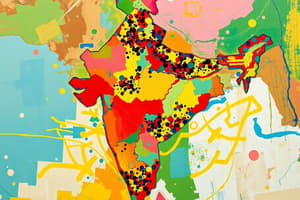Podcast
Questions and Answers
What influences population distribution according to the text?
What influences population distribution according to the text?
- Access to healthcare
- Economic opportunities (correct)
- Weather patterns
- Cultural traditions
During the Industrial Revolution, what led to increased urbanization?
During the Industrial Revolution, what led to increased urbanization?
- Religious practices
- Discovery of mineral resources (correct)
- Spread of infectious diseases
- Social media influence
What has urbanization in recent times resulted in?
What has urbanization in recent times resulted in?
- Decreased population density in cities
- Political barriers for movement
- Creation of metropolitan areas (correct)
- Shift from cities to rural areas
Why has mass migration from developing to developed regions become less likely?
Why has mass migration from developing to developed regions become less likely?
What is a consequence of people moving from rural areas to cities seeking better opportunities?
What is a consequence of people moving from rural areas to cities seeking better opportunities?
Why is understanding population distribution important according to the text?
Why is understanding population distribution important according to the text?
Which of the following factors typically leads to higher population densities?
Which of the following factors typically leads to higher population densities?
Which climatic condition is generally associated with higher population densities?
Which climatic condition is generally associated with higher population densities?
What factor related to natural resources can contribute to higher population densities?
What factor related to natural resources can contribute to higher population densities?
Which of the following factors is least likely to contribute to higher population densities?
Which of the following factors is least likely to contribute to higher population densities?
What is the primary reason for higher population densities in areas with fertile soils?
What is the primary reason for higher population densities in areas with fertile soils?
Which factor related to water resources contributes to higher population densities?
Which factor related to water resources contributes to higher population densities?
Flashcards are hidden until you start studying
Study Notes
Introduction
Population distribution refers to the spatial arrangement of a population within a given region or country. Understanding population distribution is crucial for various reasons, including resource management, infrastructure planning, and socioeconomic analysis. This article provides an overview of population distribution, discussing various factors that influence population movement and density.
Key Factors Influencing Population Distribution
There are numerous factors that contribute to population distribution, including:
-
Relief and landforms: Lowland plains, flat river valleys, and deltas typically have higher population densities due to their potential for agricultural activities. On the other hand, mountainous areas with steep slopes and poor quality soil tend to have lower population densities.
-
Weather and climate: Temperate areas with moderate climates tend to attract more people, as they offer suitable conditions for human habitation.
-
Soil type and quality: Areas with fertile soils that support agricultural production usually have higher population densities.
-
Water supply: Access to clean water is essential for human survival and development, leading to higher population densities in areas with adequate water supplies.
-
Raw materials and natural resources: Regions rich in natural resources such as minerals or oil can attract large populations due to employment opportunities.
-
Natural threats: People tend to avoid areas prone to natural hazards, such as earthquakes, hurricanes, or disease outbreaks.
-
Human factors: Some human factors can significantly influence population distribution, such as accessibility, economic opportunities, and political decisions.
Shifts in Population Distribution Over Time
Over centuries, population distribution patterns have evolved due to various demographic and societal changes. For example, during the Industrial Revolution, the discovery of mineral resources led to increased urbanization and the emergence of dense population concentrations. Similarly, historical events and government policies have played a role in shaping population distribution.
In recent times, urbanization has led to the creation of metropolitan areas and megapolises, where people move from rural areas to cities seeking better opportunities. Additionally, mass migration from developing to developed regions has become less likely due to political barriers. However, despite these challenges, around 30 to 35 million people are estimated to be moving from one country to another without official documents.
Conclusion
Understanding population distribution is vital for various aspects of human life, including resource management, infrastructure planning, and public health. By examining different factors influencing population distribution, we can develop strategies to address emerging challenges and ensure sustainable human settlement patterns.
Studying That Suits You
Use AI to generate personalized quizzes and flashcards to suit your learning preferences.




